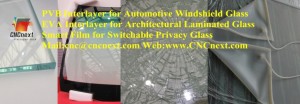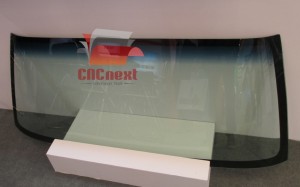Month: May 2012
TOOLS FOR DIY BUSBAR OF SMART GLASS FILM
Vacuuming And Heating Instruction of Polyvinyl Butyral PVB Interlayer Film.pdf
Delamination Analysis of Laminated Glass with Polyvinyl Butyral PVB Interlayer Film
Delamination Analysis of Laminated Glass with Polyvinyl Butyral PVB Interlayer Film

Condition One: Delamination Appears in Lines
Reason:
When combining the glass with the Polyvinyl Butyral PVB interlayer film, some folds occur , or some place of Polyvinyl Butyral PVB interlayer film is too thin due to the hard pulling of the Polyvinyl Butyral PVB interlayer film. Especially the place near the hole or edges, some Polyvinyl Butyral PVB interlayer film have been shrink, so the Polyvinyl Butyral PVB interlayer film is too thin or even gone between the too glasses.
Solution:
When combining the glass with Polyvinyl Butyral PVB interlayer film, pull the Polyvinyl Butyral PVB interlayer film gently, make sure no fold of Polyvinyl Butyral PVB interlayer film, and the Polyvinyl Butyral PVB interlayer film is 2mm wider than the glass. And also cut the Polyvinyl Butyral PVB interlayer film gently.
Condition Two: Delamination in Edges and Holes of Laminated Glass with Polyvinyl Butyral PVB Interlayer Film
Reason:
The plainness of the edges and holes of the tempered glass is not good.
Solution:
Adjust the plainness of the tempered glass, clip the edges of the pre-laminated glass before putted into the autoclave. But don’t use too big clips, in case the PVB Film’s shape changes.
Condition Three: Delamination on Edges and Holes After the Laminated Glass is Installed in the Building
Solution: Install the laminated glass gently. it’s better if use the wrench with scale to hole the laminated glass. Make sure the glass glue is suitable for the laminated glass, and it should be neutral glue.
Condition Four: Irregular Delamination of Laminated Glass with Polyvinyl Butyral PVB Interlayer Film
Reason1:
The Adhesion of Polyvinyl Butyral PVB interlayer film and glass is not strong.
Solution1:
The washing glass water is not good quality, it’s better use the water whose electric conductivity is lower than 20us.
Solution2:
The Polyvinyl Butyral PVB interlayer film absorbed too much moisture, maybe more than 6%. If moisture of Polyvinyl Butyral PVB interlayer film is higher than 1%, the laminated glass may appear white haze.
Solution3:
The combination of pre-laminated glass and roller exhausting air stage maybe not operate correctly, which lead to Polyvinyl Butyral PVB interlayer film not reacted perfectly. The main parameters are temperature, pressure and time.
Solution4:
The glass surface is not clean and dry enough.
Reason2:
The Polyvinyl Butyral PVB interlayer film is too thin.
Solution:
Use thicker or more layer of Polyvinyl Butyral PVB interlayer film.
Reason3:
The plainness of the tempered glass is not good.
Solution: Choose better quality tempered glass.
Condition Five: Delamination of Laminated Glass with Polyvinyl Butyral PVB Interlayer Film When in Boling Water Test
Reason1:
Two much air contained inside the laminated glass with Polyvinyl Butyral PVB interlayer film.
Solution1:
Sealing the edges too early in the pre-pressure exhausting air stage, which lead to the air stocked inside the laminated glass. Although, it seams successful when the laminated glass come out from the autoclave, but when in the boiling test, the bubbles will appears.
Reason2:
The Polyvinyl Butyral PVB interlayer film has absorbed too much moisture before laminating.
Solution2:
Adjust the storage conditions, make sure the moisture of Polyvinyl Butyral PVB interlayer film is less than 0.55%.
Copyright:

All rights reserved by CNC-INTERLAYER TECH:
【1】CNC-Force® EVA INERLAYER FOR ARCHITECTURAL LAMINATED GLASS
【2】CNC-Smart® SMART FILM FOR PRIVACY SWITCHABLE GLASS
【3】CNC-Shield® PVB INTERLAYER FOR AUTOMOTIVE WINDSHIELD GLASS
Mail: [email protected]
Web: www.CNCnext.com
[email protected]/
[email protected]
Bubbles in Middle of Safety Laminated Glass of CNC-Shield® Polyvinyl Butyral PVB
Bubbles in Middle of Safety Laminated Glass of CNC-Shield® Polyvinyl Butyral PVB

Reason Possibility 1:
In the procedure of roller exhausting air, it’s too early to seal the edges of the pre-laminated glass, so the air can not be exhausted out completely in the second roller.
Solution:
Adjust the speed and temperature in the pre-laminating procedure, make sure the pre-laminated glass is not sealed before the second roller exhausting air stage. Or adjust the speed of and temperature of the silicone rubber ring, to make sure the air is totally exhausted out.
Reason Possibility 2:
The Polyvinyl Butyral PVB interlayer film already absorbed too much moisture.
Solution:
Check the moisture of the Polyvinyl Butyral PVB interlayer film, and the humidity of the laminating room and glass surface.
Reason Possibility3:
The plainness of the tempered glass is not good enough.
Solution:
Choose good quality tempered glass, or use thicker Polyvinyl Butyral PVB interlayer film.
